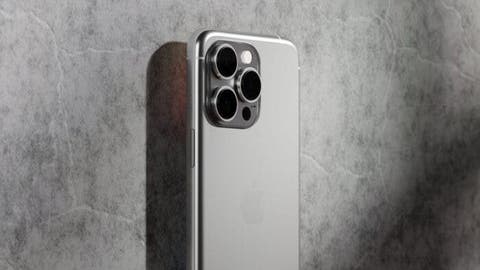In a research report shared by Barclays analysts, Blayne Curtis and Tom O’Malley this week, the iPhone 15 series models will support Wi-Fi 6E. The report via MacRumors did not specify the models that will use this feature. There is no indication whether all the models will have it or if it will be exclusive to the Pro models. So far, Apple has added Wi-Fi 6E support to a handful of devices. These include the latest 11-inch and 12.9-inch iPad Pros, 14-inch and 16-inch MacBook Pros, and Mac mini models. In addition, all iPhone 14 models remain limited to the standard Wi-Fi 6.
There were reports that the iPhone 13 series and iPhone 14 series will launch Wi-Fi 6E but this never happened. Now that Apple has started bringing Wi-Fi 6E support to its latest devices, it’s very likely that the iPhone 15 will eventually support the standard. Apple is expected to launch the iPhone 15, iPhone 15 Plus, iPhone 15 Pro and iPhone 15 Pro Max in September as usual. A recent report reveals that all four models will support smart islands and USB Type-C ports. However, only the Pro models will come with the latest A17 bionic chip, solid-state volume and power buttons, and more.
iPhone 15 / Pro series will use the Smart Island display
According to The Elec, Apple is preparing to expand the Smart Island pill-shape punch hole from the iPhone 14 Pro series to all iPhone 15 series models. This will include the non-Pro version like the iPhone 15 and iPhone 15 Plus. The report points out that Apple has issued orders to component suppliers including Samsung Display, and Samsung Display has ordered etching equipment worth 24.1 billion won ($19.5 million) from the Korean company, Philoptics for the production of Smart Island display screens.
Apple is currently applying the tech to two Pro models in its latest iPhone 14 series. Thanks to this, the two models of iPhone 14 Pro and Pro Max have the Smart Island function: there are two holes, one for the front camera and the other for Face ID.
Samsung Display earlier this month bought more laser-etching equipment for punch holes in its displays from supplier Philoptics. Samsung Display, a maker of OLED panels for Apple, purchased more production than planned from other suppliers such as AP System and HB Solution last September. This is due to higher-than-expected demand for the iPhone 14 Pro Max. AP System supplies optically clear resin deposition machines, while HB Solution offers edge shading machines.
Apple has yet to apply facial recognition tech under the screen. Unfortunately, the iPhone 15 will not come with this feature. Under-screen facial recognition may come to future devices. Samsung already uses under-screen tech in its high-end phones. It’s an upgraded version of the punch-hole display, which is now covered by the screen when components underneath the hole are not in use.
BOE will ship 31 million flexible OLEDs to Apple’s iPhone, an increase of 89%
According to data from RUNTO, in 2022, BOE’s flexible OLED panel shipments will reach 79.5 million pieces, a year-on-year increase of 22.6%. Among them, the volume of shipments to Apple’s iPhone reached 31 million pieces, an increase of 89% year-on-year in 2021. As early as the end of 2021, BOE realized the import of OLED panels for almost all mainstream mobile phone brands in the world, including Apple, Samsung, Huawei, OPPO, Vivo, and Honor.
BOE will ship about 31 million pieces to Apple in 2022, an increase of 89%
In 2022, in terms of BOE’s small-size panel business, in addition to the Honor Magic Vs folding mobile phone project and the Huawei Mate 50 Pro project, the supply of Apple’s iPhone has attracted much attention. Although BOE’s supply for the iPhone 13 was adversely affected in the first half of the year, which was lower than expected; in the second half of the year, it is benefiting from the introduction of the iPhone 14. Its shipments increased by more than 140% compared to the first half of the year.
For the whole year, according to RUNTO data, BOE shipped 31 million OLED mobile phone panels to Apple, a year-on-year increase of 89%. In 2022, BOE’s share of Apple’s overall OLED iPhone supply including iPhone 12, 13 and 14 models has exceeded 15%, while in 2021, the share is less than 10%.
BOE targets iPhone 15 and LTPO OLED
Next, BOE’s goal will be to complete the mass production delivery and LTPO displays for Apple’s iPhone 15 in 2023. According to information from the upstream and downstream industry chain, the four iPhone 15 series phones that Apple will launch in the second half of this year will all use the same display as the iPhone 14 Pro series. The low-end Standard and Plus versions will use LTPS, and the high-end Pro and Pro Max will use LTPO OLED panels. Throughout 2023, Apple plans to purchase a total of about 101 million flexible OLED panels for the iPhone 15.
For the new models of iPhone 15 and 15 Plus, BOE has obtained Apple’s intention to purchase panels. According to industry estimates, Samsung Display (SDC) will supply 55 million pieces, LGD will supply 28 million pieces, and BOE will supply 18 million pieces. Among them, LGD is facing some issues with LTPO panel delivery for the iPhone 14 series. It had to delay until October of last year and SDC took a lot of shares. In 2023, LGD will continue to supply LTPS and LTPO products.
BOE’s specific final shipments need to observe the certification and mass production progress of the iPhone 15 in 2023, and also need to pay attention to the product progress of its important competitor, LGD. If 18 million pieces can be completed, BOE’s share of the new iPhone panel in 2023 will rise from 6% of the iPhone 14 in 2022 to about 18%. This is triple of its previous shipment.
